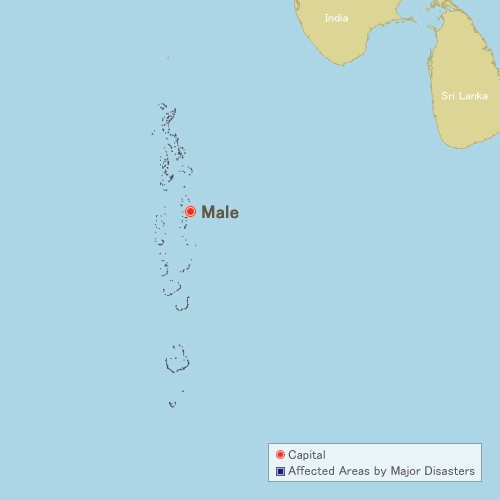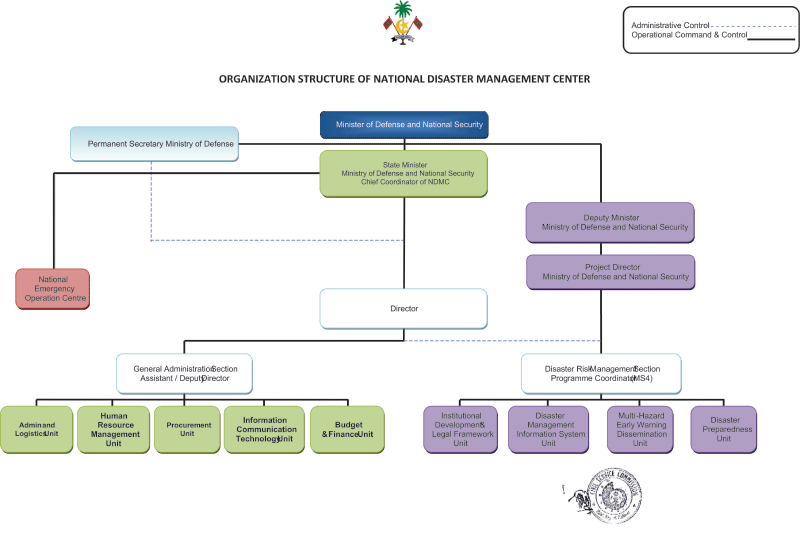TOP PAGE > Information on Disaster Risk Reduction of the Member Countries
Information on Disaster Risk Reduction of the Member Countries
 Maldives
Maldives
General Information
 Formal name: Republic of Maldives
Formal name: Republic of MaldivesThe Maldives is an island country located in the south-west of Sri Lanka, comprised of 26 atolls encompassing 1,190 islands, of which 199 are inhabited. Land area is 298 square kilometer. Climate change issue is one of the main challenges of the Maldives government since the rise of sea level threatens the existence of the islands, which rise only 1.5 meter above sea level on average. The estimated population of the Maldives is 339,330 in total, of which one-third live in Male, Capital of the Maldives, in Male island. Two seasons; dry season (from December to April, northwest monsoon) and rainy season (from May to November, southwest monsoon) dominate the Maldives' weather.
Overview of Disasters
Major disasters are storm, flooding, earthquake and tsunami. In addition, some islands of the Maldives have experienced fresh water shortage during the dry season because of increased salinity of the ground water since the 2004 Indian Ocean Tsunami.
Recent Major Disasters
Cyclone Nilam (October-November 2012)
Tropical cyclone that originated from the Bay of Bengal hit Maldives late October and continued until the first few days of November flooding 51 islands. 28 islands were severely flooded, and 4 islands were in a critical state. The cyclone affected 33,826 people and caused an estimated US$ 133,090 in damage.
Water shortage (2005 until present)
Due to the increased salinity of the fresh water lens following the 2004 Indian Ocean Tsunami, Maldives faces a shortage of fresh water during the dry season annually. During the past 9 years, an average of 92 islands have suffered from water shortage and the government has spent over US$ 1.4 million to provide water.
Indian Ocean Tsunami (December 2004)
Indian Ocean Tsunami occurred off the Sumatra Island on 26 December 2006 devastated the Maldives, causing 82 people killed, 26 people missing and 27,214 people affected. The economic loss was approx. US$ 470 million.
Disaster Management System
Legal System
The Disaster Management Bill is in its final stages of review at the Atorney General's Office. The bill seeks to provide a platform at all levels to address disaster mitigation, preparedness, response, and recovery.
Organization
 A presidential decree established the National Disaster Management Centre (NDMC) soon after the 2004 Indian Ocean Tsunami. It was created haphazardly and its mandate was to coordinate the recovery process for the tsunami relief effort. However, as things progressed, the government handed the mandate of disaster preparedness and risk reduction as well to NDMC. At present, NDMC is under the Ministry of Defence and National Security.
A presidential decree established the National Disaster Management Centre (NDMC) soon after the 2004 Indian Ocean Tsunami. It was created haphazardly and its mandate was to coordinate the recovery process for the tsunami relief effort. However, as things progressed, the government handed the mandate of disaster preparedness and risk reduction as well to NDMC. At present, NDMC is under the Ministry of Defence and National Security. Plan
At present, Maldives lacks a disaster management strategy, policy or a plan. However, work is underway to formulate a National Emergency Operation Plan (NEOP) to define the roles, responsibilities, the standard operating procedures, and the framework required to manage disasters at every level. NDMC will publish the NEOP by the time Parliament ratifies the Disaster Management Act. Furthermore, NDMC is currently in the process of introducing a damage assessments toolkit in order for island communities to report the damages they face due to hazards. This process would introduce a tool to collect damage and needs information, and provide NDMC timely assessments of the crisis. The first phase of this project is to begin in 2013. The first phase would focus on institutionalizing the tool and establish procedures for communities to send information, for NDMC to analyze and share it with other stakeholders, and finally, how NDMC would get the pre-crisis information.
ADRC Counterpart
Country Report
Country Report 2024(English Version, PDF file)Country Report 2023(English Version, PDF file)
Country Report 2018(English Version, PDF file)
Country Report 2014 (English Version, PDF file)
Country Report 2013 (English Version, PDF file)

